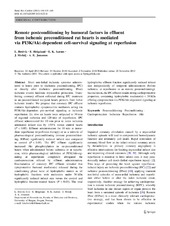Remote postconditioning by humoral factors in effluent from ischemic preconditioned rat hearts is mediated via PI3K/Akt-dependent cell-survival signaling at reperfusion
Breivik, Lars Ertesvåg; Helgeland, Erik; Aarnes, Eva-Katrine; Mrdalj, Jelena; Jonassen, Anne Kristin
Peer reviewed, Journal article
Published version

Permanent lenke
https://hdl.handle.net/1956/4569Utgivelsesdato
2010-12-29Metadata
Vis full innførselSamlinger
Originalversjon
https://doi.org/10.1007/s00395-010-0133-0Sammendrag
Short non-lethal ischemic episodes administered to hearts prior to (ischemic preconditioning, IPC) or directly after (ischemic postconditioning, IPost) ischemic events facilitate myocardial protection. Transferring coronary effluent collected during IPC treatment to un-preconditioned recipient hearts protects from lethal ischemic insults. We propose that coronary IPC effluent contains hydrophobic cytoprotective mediators acting via PI3K/Akt-dependent pro-survival signaling at ischemic reperfusion. Ex vivo rat hearts were subjected to 30 min of regional ischemia and 120 min of reperfusion. IPC effluent administered for 10 min prior to index ischemia attenuated infarct size by C55% versus control hearts (P\0.05). Effluent administration for 10 min at immediate reperfusion (reperfusion therapy) or as a mimetic of pharmacological postconditioning (remote postconditioning, RIPost) significantly reduced infarct size compared to control (P\0.05). The IPC effluent significantly increased Akt phosphorylation in un-preconditioned hearts when administered before ischemia or at reperfusion, while pharmacological inhibition of PI3K/Akt-signaling at reperfusion completely abrogated the cardioprotection offered by effluent administration. Fractionation of coronary IPC effluent revealed that cytoprotective humoral mediator(s) released during the conditioning phase were of hydrophobic nature as all hydrophobic fractions with molecules under 30 kDa significantly reduced infarct size versus the control and hydrophilic fraction-treated hearts (P\0.05). The total hydrophobic effluent fraction significantly reduced infarct size independently of temporal administration (before ischemia, at reperfusion or as remote postconditioning). In conclusion, the IPC effluent retains strong cardioprotective properties, containing hydrophobic mediator(s)\30 kDa offering cytoprotection via PI3K/Akt-dependent signaling at ischemic reperfusion.
Utgiver
SpringerOpphavsrett
Copyright The Author(s) 2010. This article is published with open access at Springerlink.comThe Author(s) 2010
